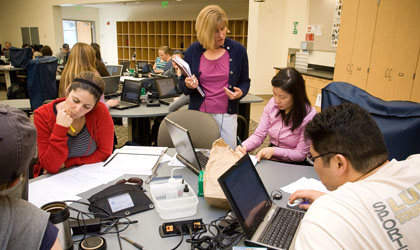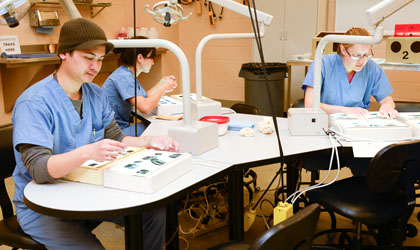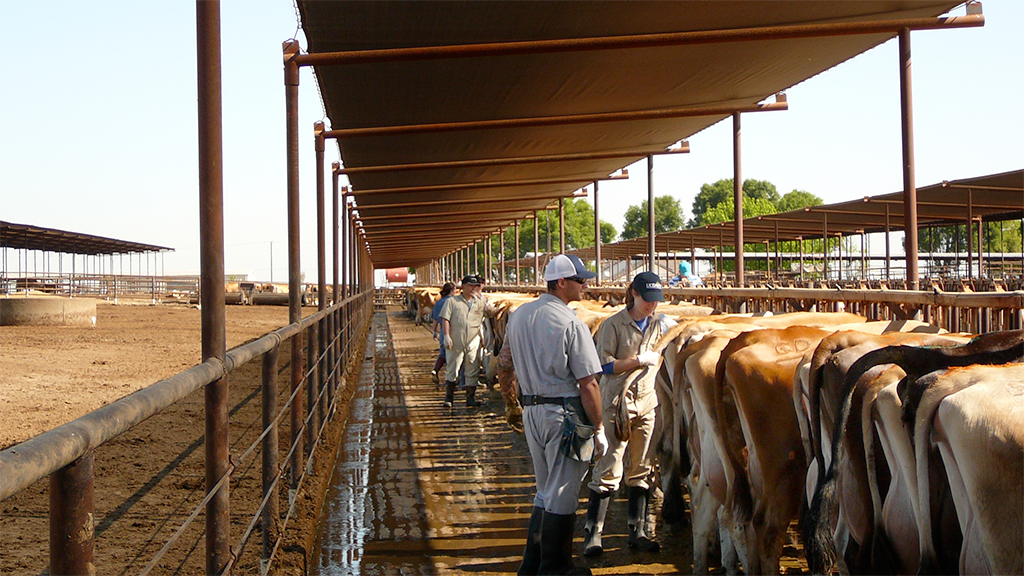Teaching Facilities
The School of Veterinary Medicine is located within the Health Sciences district of the University of California, Davis. The teaching facilities were designed to create a professional, easily-accessible learning environment that facilities a variety of educational delivery modes – traditional lecture, small group learning, and independent study; and laboratory and clinical experiential training. All learning buildings are secured with proximity card readers (also personnel identification badges), so students have 24/7 access to teaching spaces.
 Gladys Valley Hall
Gladys Valley Hall
Gladys Valley Hall is the heart of the educational program with lecture, seminar and small group teaching spaces along with lockers, showers and class homerooms. Homerooms are provided for first through third year classes. Support staff for the audiovisual needs are housed in Gladys Valley Hall.
 Multi-Purpose Teaching
Multi-Purpose Teaching
Multi-Purpose Teaching houses large aesthetically pleasing ergometric laboratory spaces downstairs with custom-designed tables for laptop computers and binocular microscopy and peripherally-located wet bench space. One of the large upstairs laboratory spaces allows interactive small group teaching in a large group environment while the other has been converted to the Clinical Skills Laboratory where students have 24/7 access to gain skill competency through practice with models and task trainers.
 Vet Med 3A
Vet Med 3A
Vet Med 3A is largely a faculty office and research laboratory space however the bottom floor space houses the VMTH pathology service and the anatomy teaching laboratories. The anatomy laboratory is a modern space that allows traditional dissection guided by digital content delivery. Downdraft tables allow exhaust collection from cadavers to minimize formaldehyde exposure.
 Gourley Clinical Teaching Center
Gourley Clinical Teaching Center
Gourley Clinical Teaching Center is where all live animal teaching takes place. The building was designed primarily for teaching anesthesia and surgery for both small and large animals and features a large modern small animal surgical suit with 28 fully equipped surgical stations. There are 2 large rooms with 8 standing stocks for either cattle or horses. A kennel area provides accommodation for dogs and cats while a barn houses horses, cattle, sheep, goats and pigs as needed. Equipment includes digital radiography, ultrasound, dentistry and laboratory equipment for hematologic and biochemical analysis.
 William R. Pritchard Veterinary Medical Teaching Hospital
William R. Pritchard Veterinary Medical Teaching Hospital
William R. Pritchard Veterinary Medical Teaching Hospital serves as the primary clinical teaching setting for professional veterinary students and residents. It also serves the public by offering high quality clinical veterinary services to more than 50,000 patients each year—from the family cat or dog to exotic birds, fish and livestock. Hospital cases support the school’s teaching and research programs, while clinical faculty provide the highest quality medical, surgical and diagnostic skills.
 Veterinary Medicine Teaching & Research Center - Tulare
Veterinary Medicine Teaching & Research Center - Tulare
The VMTRC serves as a satellite teaching facility for senior veterinary students and residents seeking to expand their dairy production medicine experience. These students and veterinarians benefit from hands-on training in a clinical and lab setting best suited to meet their educational needs. Located in the heart of California’s dairy industry, the VMTRC utilizes Tulare County’s 285 dairies with an average herd size of 1,700. These important resources provide students and residents quantitative skills that can be utilized in the interest of controlling and preventing economically important diseases and improving the efficiency of dairy cattle production. Other skills developed include applied computer science, health management and food safety issues.
